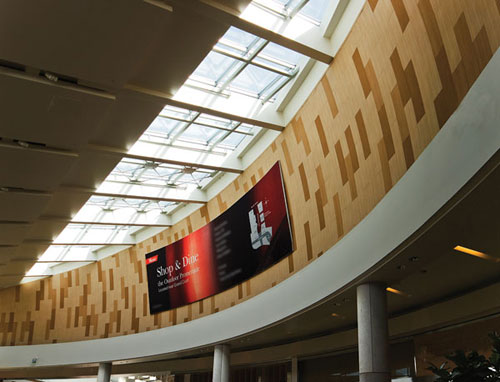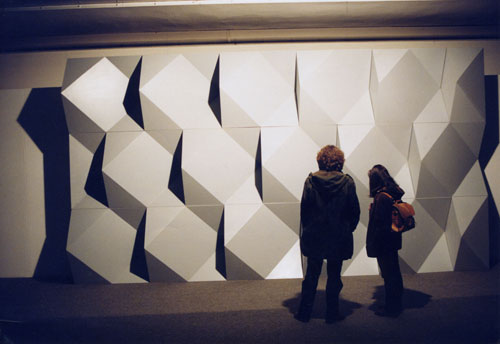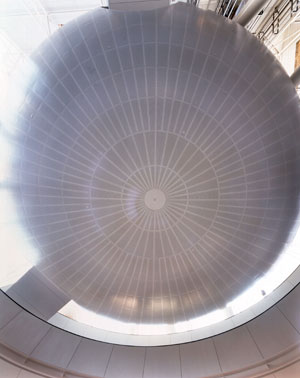Form Follows Fun: Design Options in Modern Ceiling and Wall Systems
Polyhedrons & Curves
 |
Panels are curved in both the X and Y axes to create a gently curving wall Photo courtesy of Ceilings Plus |
 |
Wall in the Museum of Modern Art, Lodz, Poland shows a great variety of shadows and highlights, but consists of just a single k-dron-shaped panel type. Rows are offset and panels are individually rotated to create visual interest. Design and Photo by Janusz Kapusta |
 |
3-D surfaces can also be tessellated. Panels laid out along longitude and latitude lines are shown in this view of the underside of the New Hayden Planetarium at the Rose Center for Earth and Space, Museum of Natural History, New York City. The 87-foot diameter sphere is clad with metal panels with over 5 million perforations to help control noise. Design: Polshek and Partners .Photo courtesy Ceilings Plus |
Ceilings and walls can enter the third dimension. Curved panels no longer require the expense of separately fabricating and attaching curved angles to stiffen the edges, or the complications of finishing the panels after assembly. Now, prefinished panels with integrally-formed returns can be shaped into concave, convex, or compound curves, with all of the design options and performance properties available for flat panels.
Flat panels can be folded to occupy two or more planes. Flat elements can also be assembled into polyhedral panels. Rotation of polygons creates another set of design opportunities. For example, the wall shown in the photo from the Museum of Modern Art in Lodz, Poland (see photo above) is composed of a single polyhedral form - the k-dron, a geometric shape discovered by architect Janusz Kapusta. Rotating adjacent panels allows a single square module to be assembled into combinations that capture light and shadow in endless ways and can be used to diffuse sound reflections.
Linear Systems
Other beneficiaries of the fabrication revolution are linear ceilings or walls. Linear systems have been re-invented to present the appearance of volume with very little actual weight. Formed from light gauge aluminum and executable in a range of metal and wood finishes, slats, struts, strips, boards, beams, and other linear components can be pre-assembled into ultra-lightweight panels. The forming technology accommodates virtually any width and depth, and the elements can be arrayed in any spacing or configuration. Pre-assembly into panels speeds installation. Panels can be attached via torsion springs, providing rapid access to the plenum in a manner similar to flat panels.
 |
In J. Alexander's Restaurant, lightweight linear systems with deep returns give the sense of substantial wood timbers with only a fraction of the dead load. Images courtesy of Ceilings Plus |
Linear systems can lead the eye and define a space without seeming to close it in. They emphasize a sense of structure. Linear ceilings can provide effective acoustical control through the use of perforations, either on the horizontal face for pattern effects, or on vertical surfaces where the holes are effectively invisible. The linear elements mate well with linear air diffusers and lighting fixtures for an integrated ceiling.
Hallway and Narrow Room Options
Hallways and narrow rooms present particular aesthetic and logistical challenges. It is quite common for opposing walls of a room to be slightly out of square, or hallway widths to vary slightly. In such cases, field-fitting a traditional ceiling system can be a disproportionately costly process.
One manufacturer offers a formed metal system involving expandable side panels, which resolves these issues. The central section of the system is mounted to the suspension system. The side panels are then slid out to fill the remaining width of the space, accommodating and concealing size variations. Central and side panels can be either matching or contrasting finishes, giving the designer a wide range of options. Side panels retract for above-ceiling access.









